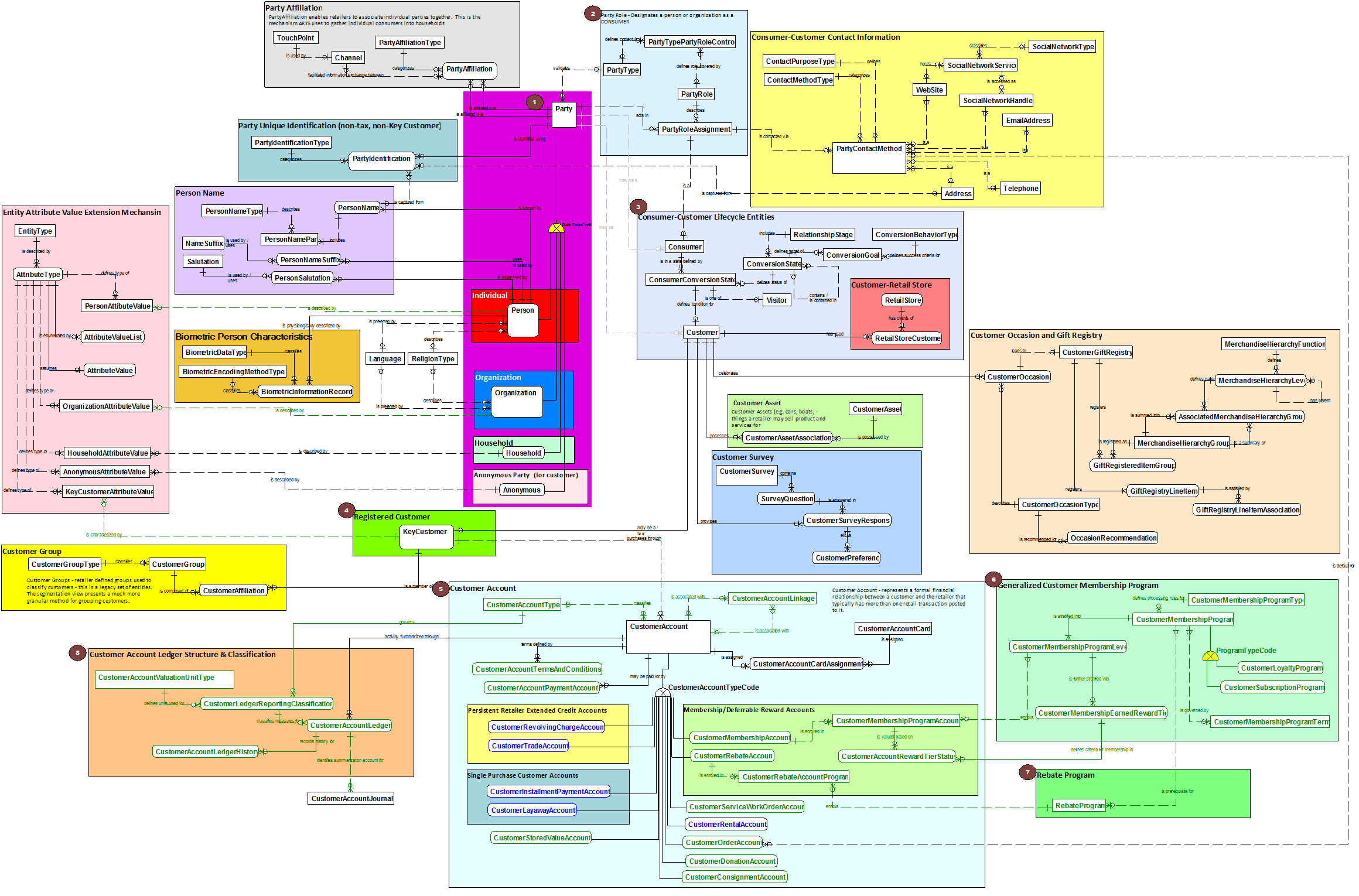Subject Area Concepts ARTS maintains an extensive set of customer-related entity types as illustrated in the following entity diagram. This section of the data model narrative takes this large model and breaks it down into smaller components based on the colored blocks below. The sequence of presentation of the components is indicated by the circled numbers next to each colored block. This approach walks the reader through this diagram beginning with the concept of Party. The circled numbers show the sequence of the pieces of the data model that trace the data dependencies from Party through CustomerAccount explained in theLogical 07010.01 - Party to Key Customer Mapping subsection. Figure 9 - Customer Information - Extended View
This subject area takes the Logical 07000 - Core Customer Entities view and expands it to include all of the contextual entities that fully describe consumers and customers. This view provides a large, inclusive view of how ARTS ODM 7.2/7.3 represents customer. The green outline entities are new with the 7.3 version of the data model. The entities in this subject area are organized into colored blocks that contain entity types that describe different aspects of a consumer-customer's relationship with the retailer. As is clear from looking at the entity diagram it covers a lot of territory. Building Around Core Customer EntitiesThe primary blocks include: •The Party Affiliation (grey) block and the Consumer-Customer Lifecycle (light blue) block along with the generic party entities are the core entity types. These core entities are complemented with contextual information about consumers-customers. This contextual information includes: •Party Affiliation (light grey) block which contains entities needed to associate individuals to households •Consumer-Customer Contact Information (light yellow) block provides a whole range of different contact entities for mail, telephone, email, web and social network consumer-retailer communication channels •Name (light violet) block which contains entities needed to appropriately represent a person's name •Party Unique Identification (blue-green)- contains entities that may be used to uniquely identify a person for authentication, authorization and other business purposes. Note that the collection of non-retailer provided unique identity numbers is regulated. For example retailers in the United States should not collect social security numbers and use them as alternate identification numbers for parties. •Consumer-Customer Life cycle (light blue) contains entities needed to represent the different retailer defined conversion states and conversion events that document the consumer's journey throughout their association with the retailer. •Customer Account (turquoise) block contains the entities that identify and describe different formal, documented financial relationships between KeyCustomers and the retailer •Customer Group (medium yellow) block contains retailer defined key customer groups used for marketing and promotions •An Entity-Attribute-Value (EAV) Extension (pink) block establishes a set of entities retailers may use to add their own attributes to further describe consumers and customers. These are provided to enable adding "outlier" kinds of attributes that apply to limited numbers of consumers and customers. EAV extension methods should be used sparingly because of the performance overhead they entail •Household (light green) block establishes Household as a separate party type (see the Logical 07019 topic for a detailed explanation of Household) •Anonymous Party (light, light pink) block establishes a Party type that is used for scenarios where retail transactions cannot be ascribed to a known person, organization or household (see the Logical 07020 topic for a detailed explanation of Enterprise Anonymous Customer). In addition to these major contextual blocks, the Logical 07010 subject area provides supplementary information that includes: •Bioemetric Person Characteristics (Yellow-Orange) block that supports the capture and retention of finger prints, retina scans and other physical properties that may uniquely identify an individual •Customer Asset (lime green) block identifies kinds of assets owned by a customer that may be used by retailers that sell accessories, replacement part and services for things owned by customers •Customer Survey (medium blue) block that identifies basic survey questions and results for a customer •Customer-Retail Store (dark pink) block that indicates a direct association between a customer and a retail store (i.e. a home store concept) •Customer Occasion and Gift Registry (salmon) block captures customer celebratory events and associated gift registry information
|
